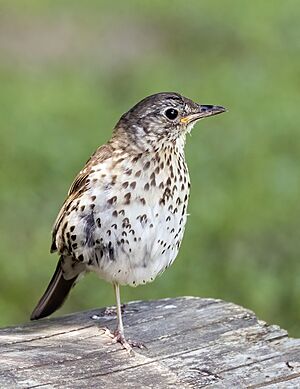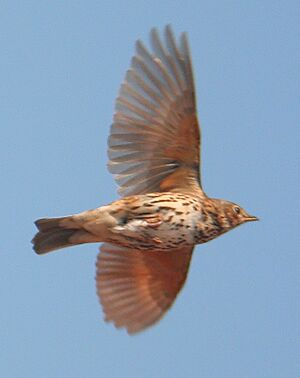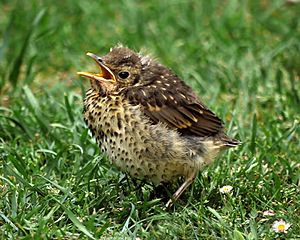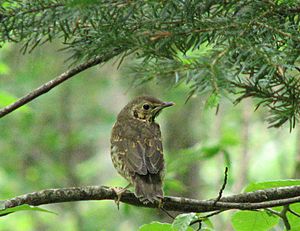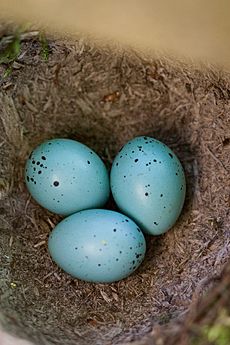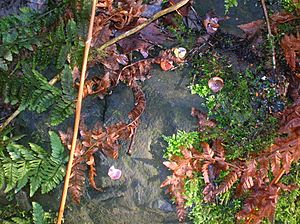Song thrush facts for kids
Quick facts for kids Song thrush |
|
|---|---|
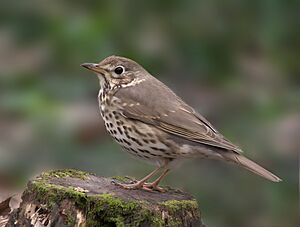 |
|
| Conservation status | |
| Scientific classification | |
| Genus: |
Turdus
|
| Species: |
philomelos
|
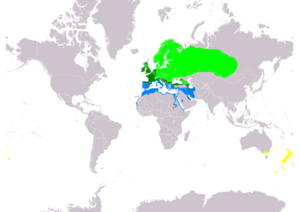 |
|
| Distribution Summer range Year-round range Winter range Introduced range | |
| Synonyms | |
|
Turdus musicus |
|
The song thrush (Turdus philomelos) is a beautiful thrush bird. It lives across Europe and parts of Asia. This bird has a brown back and a creamy chest with black spots. It is famous for its amazing and repeated musical song.
Song thrushes build their nests in forests, gardens, and parks. Many of them fly south for winter to places like southern Europe, North Africa, and the Middle East. Some song thrushes were also brought to New Zealand and Australia. Even though they are not globally endangered, their numbers have dropped in some parts of Europe. This might be because of changes in how farms are run.
This thrush makes a neat, cup-shaped nest lined with mud. It lays four to five blue eggs with dark spots. Song thrushes eat many different things, like worms and snails. They are known for using a special stone as an "anvil" to break open snail shells. Like other birds, they can be affected by tiny parasites. They also need to watch out for predators like cats and birds of prey.
Contents
About the Song Thrush
What's in a Name?
The song thrush got its scientific name, Turdus philomelos, from a German bird expert named Christian Ludwig Brehm in 1831. Turdus is the Latin word for "thrush." The name philomelos comes from an old Greek story. It refers to Philomela, a character who was said to have been turned into a singing bird. Her name means "song-loving."
You might also hear this bird called a "throstle" or "mavis." These are older English names for thrushes. "Throstle" has been used for hundreds of years. "Mavis" comes from French and Breton words that also mean "thrush."
Different Types of Song Thrushes
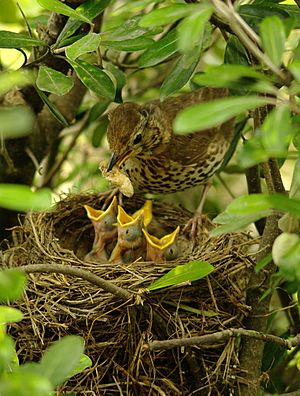
There are four main types, or subspecies, of the song thrush. Most of them are the T. p. philomelos type.
One special type is T. p. hebridensis. These birds live in the Outer Hebrides and Isle of Skye in Scotland, and western Ireland. They usually stay in these areas and don't migrate. They have darker brown backs and greyish sides.
Another type, T. p. clarkei, lives in most of Great Britain and Ireland, and parts of mainland Europe like France and Belgium. These birds have warmer brown backs and yellowish undersides. Some of them fly south for winter.
The fourth type, T. p. nataliae, lives far to the east in Siberia. These different types show how birds can adapt to their local environments.
What Does a Song Thrush Look Like?
Song thrushes are about 20 to 23.5 centimeters (8 to 9 inches) long. They weigh between 50 and 107 grams (1.8 to 3.8 ounces). Both male and female birds look similar. They have plain brown backs and creamy or yellowish undersides with neat black spots. Their bellies are usually paler. Their wings have a warm yellow color underneath. Their beaks are yellowish, and their legs and feet are pink.
Young song thrushes look a lot like the adults. However, they have buff or orange streaks on their backs and wing feathers.
How to Tell Them Apart
Sometimes, people confuse song thrushes with other birds. The redwing is similar but has a white stripe above its eye and red sides. The mistle thrush is much bigger and has white corners on its tail. The Chinese thrush looks very similar but has black markings on its face and lives in a different part of the world.
Their Amazing Song
The song thrush has a short, sharp "tsip" call. When they migrate, they make a thin, high "seep" sound. If they sense danger, their alarm call is a "chook-chook" that gets faster and louder.
Male song thrushes sing from high places like trees or rooftops. Their song is loud and clear, made of musical phrases repeated two to four times. It sounds like "filip filip filip codidio codidio quitquiquit tittit tittit tereret tereret tereret." They also add grating sounds and copy other noises. A single male can know over 100 different phrases! They learn these from their parents and other birds nearby. They can even copy sounds like telephones or other birds, even exotic ones.
Where Do Song Thrushes Live?
Song thrushes live in most of Europe, Ukraine, and Russia, almost reaching Lake Baikal. They can be found as far north as Norway. Birds from colder areas like Scandinavia and Russia fly to warmer places for winter. They spend winter around the Mediterranean Sea, North Africa, and the Middle East. Birds in milder western Europe might stay in their breeding areas all year.
In places like Great Britain, you can often find song thrushes where there are trees and bushes. This includes parks, gardens, woodlands, and hedgerows.
Thrushes in New Places
Between 1860 and 1880, some song thrushes were brought to New Zealand and Australia. People did this because they liked the birds. In New Zealand, the thrushes quickly made themselves at home. They spread to many islands there. While they are common in New Zealand, only a small group lives near Melbourne in Australia. In New Zealand, these introduced thrushes sometimes eat local insects. They can also damage fruit crops. Because they are not native, they don't have legal protection in New Zealand.
Song thrushes usually build nests in forests with good undergrowth and open spaces nearby. In western Europe, they also love gardens and parks. They can nest high up in mountains, even at 2,200 meters (7,200 feet) in Switzerland. The island thrushes in the Hebrides prefer more open areas like heathland.
In areas with a lot of farming, gardens become very important places for song thrushes to breed. One study in England found that most thrush nests were in gardens. This was even though gardens made up only a small part of the total area.
In winter, they live in similar places but avoid high, exposed areas. The Hebridean thrushes might even visit the seashore in winter.
Life Cycle and Reproduction
The female song thrush builds a neat, cup-shaped nest. She lines it with mud and dry grass. Nests are usually in bushes, trees, or climbing plants. The Hebridean subspecies sometimes builds nests on the ground.
She lays four or five bright, shiny blue eggs. These eggs have light black or purple spots. Each egg is about 2.7 by 2.0 centimeters (1.1 by 0.8 inches) and weighs about 6 grams (0.2 ounces). The female sits on the eggs alone for 10 to 17 days. After the chicks hatch, it takes about the same amount of time for them to be ready to fly. Song thrushes usually have two or three groups of chicks (broods) each year. However, in the far north, they might only have one.
Most young thrushes (about 54.6%) survive their first year. Adult thrushes have a 62.2% chance of surviving each year. A song thrush usually lives for about three years. The oldest recorded song thrush lived for 10 years and 8 months!
Challenges for Young Thrushes
Sometimes, other birds like common cuckoos try to lay their eggs in a thrush's nest. This is called brood parasitism. But song thrushes are usually good at spotting these different eggs and pushing them out.
Adult song thrushes can be caught by cats, little owls, and sparrowhawks. Their eggs and young chicks are sometimes eaten by magpies, jays, and grey squirrels.
Like many birds, song thrushes can have tiny internal and external parasites. Ticks are common and can carry tiny germs. These germs might make animals or even people sick, like with Lyme disease. Birds that feed on the ground, like the song thrush, can sometimes carry these germs.
Feeding Habits
Song thrushes eat many different things. They are omnivorous, which means they eat both plants and animals. Their diet includes invertebrates like earthworms and snails. They also enjoy soft fruits and berries.
Like their relatives, the blackbirds, song thrushes look for food by sight. They often run a bit, then stop and look on open ground. They also search through fallen leaves to find tasty treats.
Snails are a very important food, especially when it's dry or cold. When other food is hard to find, snails become a lifesaver. The thrush will pick up a snail and carry it to a favorite stone. This stone acts as an "anvil." The bird then smashes the snail's shell on the stone to get to the soft body inside. Young thrushes learn this skill by playing with objects until they figure out how to use the anvil. Baby thrushes are mostly fed animal food like worms, slugs, snails, and insect larvae.
The grove snail is a common meal for song thrushes. These snails have different shell patterns. Scientists think these patterns might help the snails avoid being eaten by birds like the thrush.
Protecting Song Thrushes
The song thrush lives in a very large area, covering about 10 million square kilometers (3.9 million square miles). There are many song thrushes, with an estimated 40 to 71 million birds in Europe alone. Because of their wide range and large numbers, they are currently listed as a species of "Least Concern" by the IUCN Red List. This means they are not considered globally threatened.
However, in some places like Great Britain and the Netherlands, their numbers have dropped by more than 50%. This is a serious decline. Experts believe these drops are mainly due to changes in farming over recent years. For example, losing hedgerows, planting crops in autumn instead of spring, and using more pesticides might reduce their food and nesting spots. In gardens, slug and snail poisons could also be a danger. Sometimes, thrushes are accidentally hit by cars when they are on roads, especially when they use the hard road surface to smash snails.
Song Thrushes and People
The song thrush's beautiful song has inspired many poets. The 19th-century British poet Robert Browning wrote about the thrush repeating its song:
That's the wise thrush; he sings each song twice over,
Lest you should think he never could recapture
The first fine careless rapture!
Another poet, William Wordsworth, also mentioned the thrush in his poem The Tables Turned:
Hark, how blithe the throstle sings
And he is no mean preacher
Come forth into the light of things
Let Nature be your teacher
The song thrush is also the symbol of the West Bromwich Albion Football Club. This was chosen because the pub where the team used to get ready had a pet thrush in a cage. This gave the team their early nickname, "The Throstles."
Thrushes as Food and Pets
For thousands of years, people in some parts of the world have hunted thrushes for food. This practice continues today in some areas, especially around the Mediterranean.
In the past, up to the 19th century, song thrushes were sometimes kept as cage birds because of their lovely singing voices. Today, there's little evidence that hunting or keeping them as pets significantly affects their overall wild populations.
See also
 In Spanish: Zorzal común para niños
In Spanish: Zorzal común para niños



